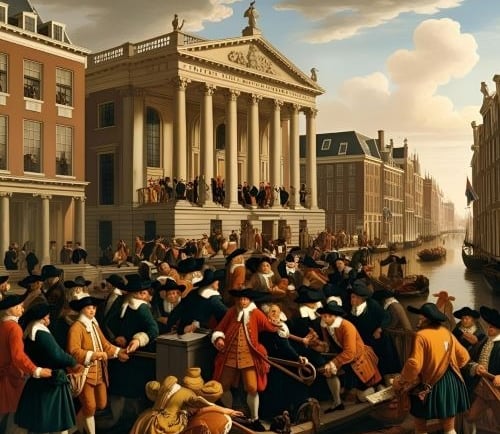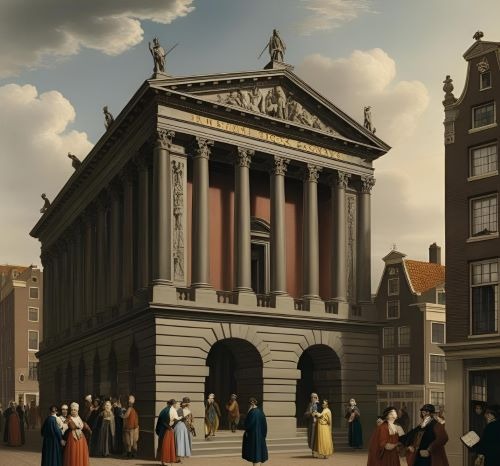Amsterdam Financial History Tour: From the VOC to Resistance Banks
Join our Amsterdam Financial History Tour—discover the 1600s stock exchange, the VOC legacy, WWII Resistance banks, and a century-old vault on this dramatic walking experience.
NETHERLANDSINDOOR ACTIVITIES
5/23/20256 min read
DISCLOSURE:
There may be affiliate links on this post. If you buy something using these links i may receive a small commission at zero cost to you.
The Origins of Amsterdam's Financial Power
The emergence of Amsterdam as a financial powerhouse can be traced back to the 17th century, specifically with the establishment of the Vereenigde Oostindische Compagnie (VOC). This distinctive trading company is regarded as the world's first multinational corporation, pioneering an innovative approach to trade and finance that would revolutionize not only the Dutch economy but also the global landscape. Formed in 1602, the VOC was granted a unique charter, allowing it to operate under a government-sanctioned monopoly on trade with Asia, which significantly enhanced its economic influence.
The VOC played a pivotal role in shaping Amsterdam's financial infrastructure, creating a model for future corporate entities. Its innovative funding methods included issuing stocks to the public, a concept that facilitated investment and spread financial risk among shareholders. This practice led to the establishment of the Amsterdam Stock Exchange, which is regarded as the world's first formal stock market. By allowing investors to buy shares in the VOC, the company was able to amass vast amounts of capital, thereby financing extensive trade expeditions and establishing a global trading network that extended from the East Indies to Europe.
The impact of VOC's trade routes was profound, as they connected Amsterdam to a wealth of commodities and resources across Asia, which were highly sought after in Europe. Spices, silk, and other valuable goods flowed through these trade networks, dramatically increasing the profitability of the company and, consequently, the wealth of Amsterdam. As a result, the city flourished during the Dutch Golden Age, emerging as a leading financial hub characterized by innovation, cultural richness, and economic strength. The foundations laid by the VOC not only drove Amsterdam's financial success but also set a precedent for modern capitalist enterprises and global trade cooperation.
The Birth of the Amsterdam Stock Exchange
The establishment of the Amsterdam Stock Exchange in the early 17th century marks a significant milestone in financial history, recognized as the world's first formal stock market. This innovative platform emerged from the burgeoning trade activities of the Dutch East India Company (VOC), which needed a mechanism to raise funds for its expansive maritime endeavors. The VOC's unique financial structure allowed it to issue shares, attracting investors eager to participate in the burgeoning global trade.
Initially, shares represented a claim on the profits derived from trade voyages, which were inherently risky yet potentially lucrative. As the demand for shares grew, a structured market began to take shape. Merchants and investors flocked to Amsterdam seeking opportunities for speculation and investment—a practice that became integral to the financial landscape. This led to the establishment of regular trading sessions where stock transactions were executed, thus facilitating liquidity and fostering market growth.
Several key moments contributed to the evolution of stock trading. For instance, the introduction of the concept of “joint-stock companies” allowed multiple investors to pool their resources, thus diversifying risk and enhancing capital availability. This not only revolutionized investment practices but also changed the societal fabric of Amsterdam, as newfound wealth shifted social hierarchies and influence. The speculative nature of stock trading, however, also ushered in volatility, as seen during events like the infamous tulip mania, which underscored the precariousness of speculative investments.
The Amsterdam Stock Exchange fundamentally transformed financial markets by establishing frameworks for trading, regulation, and risk management. Its emergence had far-reaching implications not only for Amsterdam but also for global financial systems, laying the groundwork for future stock exchanges worldwide. The innovations borne out of Amsterdam would influence the evolution of finance, where the synergy of trade, investment, and speculation would pave the path for modern economic practices.
Resistance Banks and Their Role During WWII
During World War II, the impact of Nazi occupation profoundly affected every aspect of life in Amsterdam, including its financial systems. In response to the oppressive control exerted by Nazi banks, a series of clandestine financial institutions, commonly referred to as resistance banks, emerged. These institutions were born from the necessity to provide financial support to the resistance movements and to offer alternative avenues for individuals and families who suffered under the occupation.
Resistance banks were typically organized by groups of courageous individuals who sought to undermine Nazi authorities and provide sustenance to those in need. They functioned outside the conventional banking system, creating a network to facilitate transactions that would ensure the flow of resources to the resistance fighters, albeit in a covert manner. Not only did these banks finance the resistance's activities, but they also helped ordinary citizens maintain a semblance of financial stability in a time of turmoil.
The moral implications of banking during wartime became increasingly complex as these institutions operated in a gray area, balancing the fine line between survival and complicity. The individuals involved in these resistance banks displayed remarkable ingenuity, navigating the risks of reprisals and potential imprisonment while upholding their ethical convictions. The establishment of these banks represented an audacious act of defiance against the oppressive regime, reflecting the resilience of the human spirit against tyranny.
As the war progressed and the horrors of Nazi occupation deepened, resistance banks became lifelines for many families, enabling them to access financial resources that mainstream banks refused to provide under Nazi control. These alternative banking systems were not only crucial for the survival of the resistance but also served to foster a sense of solidarity among the people of Amsterdam, highlighting the strength of community and the unwavering quest for autonomy amid despair.
Visiting Amsterdam's Financial Landmarks
Amsterdam, a city renowned for its rich history in finance, offers visitors a unique opportunity to delve into a diverse range of financial landmarks that narrate the story of its economic evolution. A must-visit site is the historic Amsterdam Stock Exchange, recognized as the world’s first official stock exchange established in the early 17th century. Located at the Beurs van Berlage, the legacy of trading and the origins of corporate finance can be felt within its walls. Here, tourists can appreciate the architectural significance and learn how this institution laid the foundations for modern financial markets.
Another iconic location is the Central Bank of the Netherlands, known as De Nederlandsche Bank (DNB). Constructed in the late 20th century, this institution emphasizes the city’s role in national and international monetary policy. Visitors can gain insight into various aspects of Dutch banking history and its pivotal role in Europe’s financial landscape. Engaging with exhibits within the bank often reveals how financial institutions are not just places for transactions but are also significant cultural entities that mirror societal changes over time.
As you wander through the city, do not miss the opportunity to explore the old bank vault at the Amsterdam Museum, where a collection of historical artifacts showcases the evolution of banking practices in the region. When navigating these historical sites, it is advisable to join a guided tour led by local historians or financial experts. They can provide deeper insights, anecdotes, and unravel the intricate connections between Amsterdam’s history and its financial institutions. With ample learning opportunities, a walking tour through Amsterdam's financial landmarks is not only educational, but also a captivating experience, illustrating the enduring impact of finance on the city's identity.
Summary:
Discover the untold stories behind Amsterdam’s financial rise on this captivating walking tour.
Uncover the world’s first stock exchange and the birthplace of the first-ever limited company—both born from 17th-century trade in Amsterdam’s bustling port.
Journey through clandestine WWII Resistance banks that defied Nazi control, and step inside a century-old vault preserved in time.
Witness how money shaped the city’s culture and heritage, and explore hidden gems around every corner.
With a private, fully flexible itinerary, you’ll enjoy an intimate, photo-friendly experience of Amsterdam’s most iconic—and secret—financial landmarks.
Includes:
Gain exclusive access to the City’s archives and step inside historic bank vaults on this private, fully flexible walking tour.
Uncover the world’s first stock exchange and explore the origins of the first limited company in 17th-century Amsterdam.
Discover secret WWII Resistance banks that stood up to Nazi finance, wander through hidden gems, and see how money forged the city’s culture and heritage.
Perfect for photo enthusiasts, this intimate experience brings Amsterdam’s iconic—and overlooked—financial landmarks to life.








